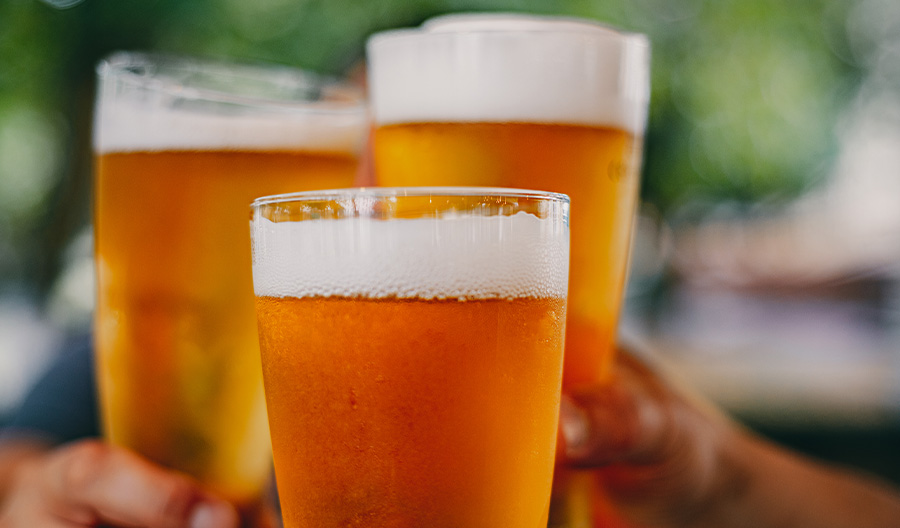While Micheladas are a summer staple, what role does a beer cocktail have when the mercury drops? Surprisingly, quite a large one. From winter-citrus shandies to scotch-whisky-heavy nightcaps paired with chocolatey porters, beer can be an exciting seasonal ingredient in the colder months, too.
As with any cocktail ingredient, the choice of beer used is heavily influenced by the weather and seasons. Heavier, fuller beers pair well with cold-weather flavors like spices, ginger, heavy-bodied vegetables, and fruits.
As a cocktail ingredient, beer contains multitudes. “There's no one way to work beer into your cocktails,” says Charles Joly, the official mixologist for the Oscars and Emmys. “It can be a complimentary topper, work as the broader foundation, be cooked down into a syrup, or even turned into bitters. The bartender's creativity is the only limit.”
Joly finds there’s “a wild diversity of flavors to work within beer,” he says. “Simple, light lagers, bitter-hoppy IPAs, rounded, nutty cacao notes in stouts, and acidic fruit flavors in sours. That said, don’t let creativity get ahead of a good cocktail.” Cocktail experts offer advice on balancing the perfect seasonal beer cocktail.
Select Your Suds
If your business has a menu with a large variety of beers, it is imperative to be able to incorporate the beer culture of the place into you cocktail program. Cross-utilizing your program will better engage your clientele and make them aware of other facets of your menu.
There are many resources available to bartenders to accomplish this. Most beer companies will tell you what flavors are imparted by the hop infusion. The best breweries will be explicit about their malt as well. From there, bartenders can create cocktails around the complementary and contrasting pairs of those base flavors.
Experiment with pairing chocolate, raspberry, or strawberry with beers that use chocolate malts or have a deeper roast on the barley. If a beer that has Citra hops in it, you can pretty much guarantee that grapefruit will work in your cocktail.
Highlighting beer has its business benefits. For cost-effectiveness behind the bar, use beer on tap. Try using tap beer as a bubbly topper for drinks, just as one would use sparkling wine or soda water. If you are looking to use it as the CO2 for a cocktail, treat the beer as you would any other sparkling beverage; don't shake it, keep it extremely cold to lock in the bubbles as long as possible, and cap it overnight if you can.
If you don’t have access to beer on tap, however, and you have extra left over in a bottle or can, you can always turn it into a syrup and repurpose it for another cocktail. See How to Use Beer Syrups in Your Drinks (link to the beer syrup article) for how to use beer syrups in your cocktail program.

Brew Up Flavors
Any beer with a fruit-forward flavor, or a prominent coffee/chocolate flavor is easy to match in a cocktail. Think IPAs, milk stouts, ciders, and sour ales. The carbonation in beer gives any cocktail an extra fizz or adds to the body of the drink.
Try adding IPA as a float in a Blood Orange Margarita. The beer float adds in tangerine and peach flavors as well as a bubbly component to compliment the cocktail. Sour ales are a fun beer to pair with gin, orange cordials, or possibly vermouth, depending on the flavor in the beer.
One bartender in Santa Clara, California, loves “spicing up an IPA with spicy flavors and comfort food familiar to me,” he says. “I was born and raised in San Francisco Bay, and coming from a Mexican American family, I like to play with a variety of comfort foods. Spicy dishes, decadent chocolates, and cinnamon spice—anything vibrant with color and rich in flavor is essential.”
No matter what you’re adding, it’s best to keep the ingredient list relatively short. Most beer already provides a pretty complex base, so adding too many ingredients can make the cocktail taste muddy and dull.
Joly adds, “Treat the beer like any other ingredients, and make sure the sum of the parts makes sense.”
Get Shaking
Remember to use the beer component to top the cocktail; don’t shake it with the rest of the ingredients. Beer is carbonated, and for that reason, you don’t want to release all the gas when you can add fizz to a cocktail. Add the beer at the end, to top off a drink or stir gently with other ingredients.
While Micheladas and Shandies are standards, you can use beer to lean further into seasonal flavors. Try matching stouts with amari or dark spirits like rum and whiskey. Ciders can go with any flavor, depending on the type of cider that is being used. An ale like a cream ale would pair well with a spicy cocktail.
When it comes down to it, though, there are no hard-and-fast rules and a plethora of options: Make a frothy flip with pedro ximenez sherry and top it up with a malty porter; lean into bright winter citrus and spices of the season; balance weisse beers with ginger syrups; or top up a Paloma with a bitter IPA. Experiment to find your perfect winter beer cocktail match.

